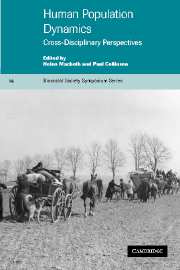Book contents
- Frontmatter
- Contents
- List of contributors
- Foreword by G.A. Harrison
- Preface
- 1 Introduction: the framework of studying human population dynamics
- 2 Demographic perspectives on human population dynamics
- 3 The growing concentration of world population from 1950 to 2050
- 4 Population, community and society in peasant societies
- 5 From genetic variation to population dynamics: insights into the biological understanding of humans
- 6 Social institutions and demographic regimes in non-industrial societies: a comparative approach
- 7 The dynamics of child survival
- 8 Genetic structure of south Indian caste populations: a confluence of biology and culture
- 9 Fertility, mortality and migration transitions in association with socioeconomic modernisation among highland minority populations in Southeast Asia
- 10 Ecology, homeostasis and survival in human population dynamics
- Glossary
- Index
- References
8 - Genetic structure of south Indian caste populations: a confluence of biology and culture
Published online by Cambridge University Press: 11 August 2009
- Frontmatter
- Contents
- List of contributors
- Foreword by G.A. Harrison
- Preface
- 1 Introduction: the framework of studying human population dynamics
- 2 Demographic perspectives on human population dynamics
- 3 The growing concentration of world population from 1950 to 2050
- 4 Population, community and society in peasant societies
- 5 From genetic variation to population dynamics: insights into the biological understanding of humans
- 6 Social institutions and demographic regimes in non-industrial societies: a comparative approach
- 7 The dynamics of child survival
- 8 Genetic structure of south Indian caste populations: a confluence of biology and culture
- 9 Fertility, mortality and migration transitions in association with socioeconomic modernisation among highland minority populations in Southeast Asia
- 10 Ecology, homeostasis and survival in human population dynamics
- Glossary
- Index
- References
Summary
The Indian subcontinent, which contains nearly one-sixth of the world's population, has received migrants from many sources during its history. Its population is consequently diverse, both culturally and genetically (Nei and Roychoudhury 1982; Majumder and Mukherjee 1993; Majumder 1998). The patterns of this diversity can offer important clues to evolutionary history. In addition, unique sociocultural phenomena in India have influenced mating patterns for thousands of years. It is expected that these patterns have in turn affected the genetic structure of the population. For these reasons, the Indian population is an appealing subject for population genetic analysis. This chapter, while concentrating on some populations in southern India, shows how modern genetic techniques can play an important part in our understanding of human population dynamics.
Three major waves of immigration have influenced the genetic structure of India. Palaeolithic immigrants are thought to have originated from Africa, or possibly Australia, and may have contributed to the gene pool of present-day tribal populations (Maloney 1974; Chandler 1988; Majumder and Mukherjee 1993; Cavalli-Sforza et al. 1994). A second major wave of proto-Dravidian-speaking immigrants came from the Fertile Crescent area c. 10,000 years ago and populated most of the subcontinent (Cavalli-Sforza et al. 1994). The third major wave, emanating from west-central Asia about 3,500 years ago, consisted of Indo-European-speaking ‘Caucasoid’ populations. This immigration event is marked archaeologically by the appearance of Painted Grey Ware (Thapar 1980).
- Type
- Chapter
- Information
- Human Population DynamicsCross-Disciplinary Perspectives, pp. 141 - 161Publisher: Cambridge University PressPrint publication year: 2002



